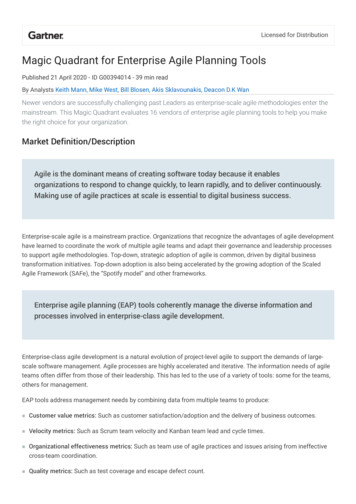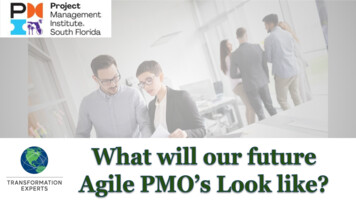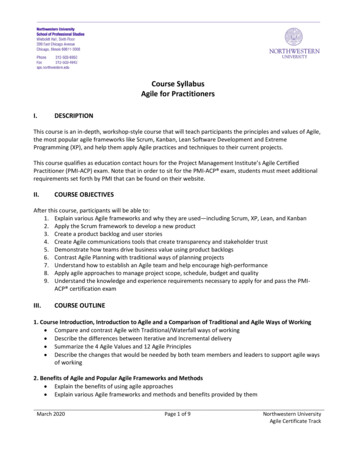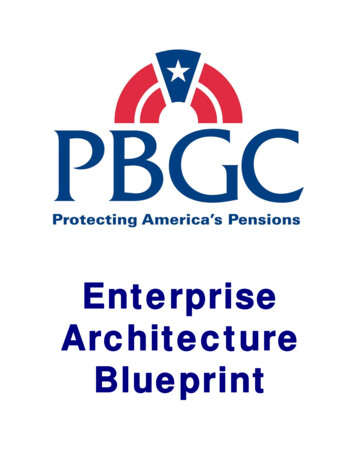
Transcription
Cognizant 20-20 InsightsDigital Systems & TechnologyCreating an Agile EnterpriseArchitectureWith the proliferation of digital, the function of enterprisearchitecture is more critical than ever. Getting there requires astrong, agile enterprise architectural foundation that can embracea fail-fast/fail-safe approach to the IT charter of stronger businessalignment, while ensuring that services are delivered fast andfriction-free to meet the needs of today’s dynamic businessobjectives.Executive summaryEnterprise architecture (EA) is often describedas the practice of implementing analyses toholistically design and execute successfulenterprise strategies that reflect the desiredNovember 2019business vision and outcomes.1, 2 Traditionally,EA has been the entity that enterprises adoptto ensure better alignment between businessand IT, while optimizing IT costs. Given the
Cognizant 20-20 InsightsA use-case prioritization approachcoupled with cognizance of analyticsmaturity offers clear direction on businessand technology strategy when buildinga use-case implementation roadmap.dynamic nature of today’s digital economy, repletewith higher volatility, uncertainty, complexity,and disruptions, the value of EA is not to simplydeliver IT value but rather how it can enhancebusiness value by enabling faster and more agileresponses to market opportunities and threats.3As a result, IT organizations must revisit the basictenets of EA including its charter, services offered,value of the services delivered, and the underlyingorganizational and operating model of what iscalled Agile EA.This white paper presents the concept of Agile EA,explains why this new model is needed, the keyelements that either need to be changed or newlyadopted, and the key guidelines to realizethe model.EA is often misunderstood and used interchangeably with solution architecture, which typicallyapplies only to a single project or project release,2/assisting in the translation of requirements intoa solution vision, high-level business and/or ITsystem specifications, and a portfolio of implementation tasks. Therefore, Agile EA can be conflatedwith an architecture definition for Agile projects,even though there are fundamental differencesbetween the two.There are various approaches such as minimumviable architecture (MVA), just-in-time (JIT)architecture, just-enough architecture,evolutionary architecture and others that definearchitectures for Agile projects while practicingsolution architecture. This paper, however, focuseson Agile EA, an emerging model for the enterprisearchitecture that can help organizations quickly andeffectively create a digital foundation that can meetbusiness needs today, and anticipate and deliver ontomorrow’s requirements.Creating an Agile Enterprise Architecture
Cognizant 20-20 InsightsAgile enterprise architecture: A primerThere are numerous reasons for IT organizationsto pursue Agile enterprise architecture, as well as arationale to move forward. They include: Why: Increase responsiveness to align withfaster change cycles. What: EA’s organizational model and focus area(competency center to service center) providesmeasures of success (i.e., from referencearchitectures to reference implementations). How: Restructure EA units based on servicesrather than architecture domains, establish EAservice catalog, simplify architecture artifactsand deliverables with just-enough information,and define impact-based key performanceindicators (KPIs) to measure and communicatethe value of the EA function.In its effort to ensure the right alignment withenterprise vision and drivers, EA has traditionallyadopted a compliance-centric approachthrough stage-gated interventions for providingarchitecture assurances. However, this modeldoesn’t scale enough in today’s fail-fast/fail-safeera where architecture assurances are expectedto be provided just-in-time, digital strategydecisions must be made as swiftly as possible, andfit-for-purpose technologies are preferred overstandardized technologies. Similarly, long cycles aretypically spent defining an enterprise technology ordomain roadmap by analyzing the current state andproposing a high-level future state with or withoutintermediate transitional states.3/At a time of rapidly changing technology, coupledwith rapidly evolving user or customer expectations,it becomes increasingly difficult to define a futurestate architecture that adequately addresses theconcerns of all stakeholders.Crucial Agile EA drivers include: Manage stakeholder expectations to fail-fastand fail-safe. Scale on demand to provide architectureservices. Reduce cycle time and adopt an incrementaldelivery of architecture services. Adapt to rapid changes in the technologylandscape. Communicate the value of adopting fit-forpurpose over standardization of technologies.In addition, an Agile EA can help IT to: Meet evolving user or customer expectations. Improve focus on insights over information (forexample, application portfolio insights overapplication portfolio information).Creating an Agile Enterprise Architecture
Cognizant 20-20 InsightsCompeting when change is the only constantThe need for EA is usually a response to thetechnology trends prevalent at that point in time.A technology-centric model was in vogue when ITbegan focusing on technological standardizationand infrastructure optimization. The rise ofcommon off the shelf (COTS) products, customsolutions, and open standards then gave way to aportfolio-centric model.It is thus natural that the transition to Agile EAnecessitates changes in key dimensions of an EAfunction (See Figure 1): EA’s focus areas. With the technology-centricapproach to EA, the focus was on technologyoptimization. This led to standardization ofthe technology portfolio and improvementof business-IT alignment (in the capabilitycentric approach). With Agile EA, the focus ofthe practice shifts toward core modernizationand innovation at scale, while enabling ITstandardization and compliance throughautomation.Maturing EA frameworks and the evolution ofindustry-specific capability models necessitateda capability-centric model. Today, IT is focusedprimarily on digital innovation, automation,DevSecOps, and Agile delivery methodologies,which calls for an Agile EA model.4MATURITYThe evolution of EA Ad hoc artifacts driven Infrastructure models Last mile assurance Technology-centric EAassessments Ad hoc KPIs Single organization Ad hoc engagement model Best practices andguidelines Standards driven Capability models Stage-gated assurance Application-centric EAassessment Standards-related KPIs Decentralized organization Standard engagementmodel Principles & standards Architecture outcomedriven Capability models Stage-gated assurance Capability-centric EA assessments EA activity KPIs Centralized organizations Capability-basedengagement model Reference architecturesTECHNOLOGY CENTRIC EA frameworks & methods Industry models Shared service platforms Social Cloud Mobile Analytics EA taxonomy Rise of COTS Open standards Technology platformsOPTIMIZETECHNOLOGYAGILE EACAPABILITY CENTRICPORTFOLIO CENTRIC Business-outcome driven Enterprise platforms JIT architecture assurance Customer-centric EAengagement EA impact KPIs Federated core organization Triaged engagement model Reference implementations Digital & automation Agile delivery DevOps MicroServices IMPROVEALIGNMENTTIMEFigure 14/Creating an Agile Enterprise ArchitectureMODERNIZE &INNOVATEIndustry trends
An Agile EA model will be business outcome-driven, servicecentric, nimble and, more importantly, focus and scale to modernizeand innovate. Customer-centric initiatives along with enterpriseplatforms will gain prominence. Key characteristics. An Agile EA model willbe business outcome-driven, service-centric,nimble and, more importantly, focus and scaleto modernize and innovate. Customer-centricinitiatives along with enterprise platforms willgain prominence. A just-in-time architectureassurance approach will be preferred over astage-gated compliance approach. Enterprisearchitects will be mapped to strategic enterpriseinitiatives rather than lines of business orportfolios as done traditionally. The organizational model. Rather than beinga centralized and consolidated group withinthe organization, EA will shift to a federatedstructure with a core organization and a triagedengagement model. The federation can beon the basis of the functional divisions withinthe organization. A federated model helpsto achieve the needed scalability. This alsodecouples the need for EA practitioners to bemasters of all technologies and domains. Thedistributed team can focus on their individualstrengths and capabilities, based on thefunctional division. Another important attributeis structuring the units of an EA function basedon the service lines rather than based ondisciplines of EA. The measurement criteria. The typicalkey result areas (KRA), which measurethe effectiveness of an EA function, havetraditionally been defined based on the activitiessuch as defining standards, as well as developing5/EA roadmaps, reference architectures, patternsand guidelines. This has shifted to impact-drivenKPIs, with an emphasis on the business valuerealized through modernization or use of any ofthe EA assets, reduced cycle time for solutiondevelopment, and/or consolidation -or rationalization -- of systems or technologies. The tools. EA tools are used for strategicdecision-making provided through capturingvital enterprise context background, along withcontent development and analysis capabilitiesacross the business, information, technologyand solution architectures.5 However, thefocus has shifted from capturing information toproving that the IT investments are deliveringthe greatest return on investment and helpingthe organization meet its strategic goals.A more integrated relationship between ITand finance is needed. Traditional EA toolsneed to either evolve or complement othertools to provide holistic technology businessmanagement (TBM) that offers IT financialplanning and insight.6, 7Agile EA takes a complete relook at the current keyEA functions as well as any new functions requiredfor EA to scale up to meet the demands of digitalbusiness and automation that fuels it. Figure 2 (seenext page) highlights some of the key differences.Creating an Agile Enterprise Architecture
Cognizant 20-20 InsightsComparing the traditional and Agile EA modelDimensionTraditional EAAgile EAStrategyFirm up strategies as part of the planning Evolve strategies and plans incrementally and iteratively.exercise and implement later.ArchitectureassuranceArchitecture review boards orcommittees carry out stage-gatedapproval process.Enable JIT architecture assurance through self-service andstand-up meetings for most projects.TechnologygovernanceDefine and manage technologystandards through validation of points ofview (PoV) by enterprise review boards.Back fit-for-purpose technology standards by proof oftechnology reference Implementations.FiduciaryresponsibilityNeed EA oversight for all projects andmanage any deviations by exception.Need EA oversight for most risky or important projectscategorized by risk tiers.Perceive as a competency center.Perceive as a services organization.Organize centralized architectureteam around the various disciplinesof EA, namely business, information,application and infrastructure.Organize federated architecture team with the core teambased on the architecture services provided.Focus on stability, risk reduction or costsavings.Focus on flexibility and scalability, learning-by-doing andexperimentation.Develop PoVs and reusable solutionaccelerators.Institute an innovation ecosystem that includes platforms andevents such as hackathons, etc.TechnologymanagementDocument-based referencearchitectures describe what should bedone.Reference implementations demonstrate how it should bedone.OperationsFocus on managing the operations ofDiversified focus includes service delivery and periodicthe EA functions – budget, people, talent standups with portfolio groups and stakeholders.management, etc.PortfoliomanagementManaging the portfolio is a core functionof EA.Managing the portfolio becomes a shared responsibility acrossthe different line of business with EA acting as the custodian.Activity basedImpact basedFor example, the number of EAroadmaps or reference architecturesdeveloped.For example, potential cost savings due to technologystandardization and mean-time to market new products.Leverage EAM tools and a documentworkspace or a portal that housesthe architecture assets like referencearchitectures, business-led technologyroadmaps, etc.Enable collaboration as well as seamless dissemination ofinformation through digital workspaces or communicationchannels with a dedicated architecture gemanagement &communicationUse periodic rosters and dashboards forcommunication with portfolio teams andother stakeholders.Store and share reference implementations with an integratedcode repository.Set up a diverse community of practitioners (CoP) toeffectively collaborate and communicate.Figure 26/Creating an Agile Enterprise Architecture
Cognizant 20-20 InsightsThe EA function’s organizational modelMost EA organizations are structured aroundbusiness, data (or information), application (orsolution) and technology (or infrastructure)architecture domains. In addition to these domains,certain organizations will have a dedicated unitfor managing the IT portfolio through standardEA management tools and an operations unitthat takes care of all operational activities of thefunction that includes budgeting, reporting, etc.Extending the widely popular Conway’s law, whichstates that organizations produce designs basedon their structure, the activities or functions of anEA organization are predominantly based on theirinternal structure.8 This kind of an organizationalstructure requires bringing together architectsfrom different units to deliver an architectureservice, such as EA roadmaps, assessments orassurance. Hence, the services tend to cut acrossoperating units. Invariably, this leads to managingand balancing the competing priorities of differentEA units and addressing internal bandwidthlimitations. Thus, each unit tends to deliver servicesthat are isolated in nature, resulting in low businessoutcome or value.To enable EA as a services organization, IT shouldbe structured based on the service lines or servicecategories rather than architecture domains as iswidely adopted today (see Figure 3).The evolution of the EA organizational modelKnowledgemanagementInfrastructure architectureOperationsReference architectureSolution architectureRoadmapsInformation architectureGovernancePortfolio managementBusiness architectureArchitecture strategy& terprise platformsServicesFigure 3To enable EA as a services organization, IT should bestructured based on the service lines or service categoriesrather than architecture domains as is widely adopted today.7/Creating an Agile Enterprise ArchitectureService delivery & operationsAGILE EAServicesTRADITIONAL EA
Cognizant 20-20 InsightsReference implementations on emergingtechnologies by the digital innovation unitwill aid in compressing the time to definebusiness-led technology roadmaps or projectarchitecture services.Each of these services (units) will be a multidisciplinary team having their own set of userexperience (UX) architects, business architects,information architects, solution architects, andtechnology architects. This aligns well with the Agilephilosophy of independent, autonomous teams toreduce dependencies and improve the velocity ofthe solution or product delivery. Each unit will havea designated service line lead that is responsible fordefining and executing architecture services withinthat service line or category.Services (units) within the EA organization mayinclude: Architecture strategy and planning. Custodianof the overall vision and direction. This unit workswith business and IT leads (CIOs and CFOs) toensure business and IT alignment on a strategiclevel. It is also responsible for enterprise-wideroadmaps. Architectural governance. Ensures thatprojects and delivery follow a common standard. Project architecture. Tasked with definingsolutions related to a given project, or set ofrequirements. Digital innovation. Tasked with developingreference implementations that can serve as thegolden standard for use in the organization. Enterprise platforms. Tasked with monitoringthe evolution of platforms such as customer8/relationship management (CRM), enterpriseresource planning (ERP), documentmanagement, etc., and advising the impactedfunctions on upcoming changes. Knowledge management. Governs andcontrols knowledge assets, such as EArepositories and other EA tools. Service delivery and operations. Functionsas the program management office (PMO) andkeeps track of available bandwidth and workloadfor different units. A large EA organizationbenefits from a dedicated delivery and operationunit in a way that the other services canconcentrate on their core area.Such a structure will allow for greater autonomy indelivering relevant EA services and also enable aclosed loop of architecture services across differentunits. For instance, reference implementations onemerging technologies by the digital innovationunit will aid in compressing the time to definebusiness-led technology roadmaps or projectarchitecture services.A dedicated knowledge management unit will beessential to govern and control the knowledgeassets across other units from architecture strategyto digital innovation. The existing operationsunit will be expanded to cover service deliveryresponsibilities within the Agile EA model, andstrongly advocates EA to be a services organizationrather than a body of architects.Creating an Agile Enterprise Architecture
Cognizant 20-20 InsightsKey benefits of this approach include:Key limitations include: Independent, self-sufficient teams with reducedcoupling between units and increased cohesion. Challenges with effective utilization of resourcesto avoid resource redundancies. Independently scale based on the services. Inability to foster a community based onarchitecture domains. The ability to exploit different sourcing modelsfor various services. For example, managedservices for architecture assurance servicesor time-boxed consulting for business-ledtechnology roadmaps or assessments, etc. Difficulty avoiding walls between units toeffectively integrate services across service lines.EA as a services organizationOne of the common perceptions about EA as anorganization is that it is merely a competency centercomprising a collection of talented architects.This setup often leads to an unsustainable andnon-scalable model, as identifying, retaining andscaling appropriate talent is highly difficult. Italso leads to non-standardization of services dueto my-way-of-doing things; and a tendency toinvolve EAs in more tactical project activities overstrategic enterprise initiatives, citing urgent needsand increased dependencies on people ratherthan process. Collectively, this results in ineffectivecommunication of the EA function’s value.As an alternative to a competency center model,the EA function should be established as aservices organization that provides a wide range ofservices to different stakeholders in the enterpriseas defined in its charter. With this approach, thevalue or impact of an EA function is determinedfirst by the kind of services it provides and if theservices can be easily mapped to the enterprise’sstrategic priorities. The services that are relevant toan organization may vary, based on the needs andpriority of the stakeholders and the organization.Having said that, each service should have aclearly articulated service definition that includesa clear definition of ready (inputs), definition ofdone (deliverables/outputs) and the process.The service definition should also include thenecessary metrics by which the effectiveness of theservice can be measured, and the metrics can beeffectively used to tie it to enterprise-level businessoutcomes and KPIs.IT organizations should institute a formal customersatisfaction survey to solicit stakeholder feedbackupon completion of a service. Each service shouldAs an alternative to a competency center model, the EA functionshould be established as a services organization that provides awide range of services to different stakeholders in the enterprise asdefined in its charter.9/Creating an Agile Enterprise Architecture
IT organizations should institute a formal customer satisfactionsurvey to solicit stakeholder feedback upon completion ofa service. Each service should also identify the collaborating aswell as dependent services for enabling a closed-loop ofEA services.also identify the collaborating as well as dependentservices for enabling a closed-loop of EA services.Complementing the organizational model, EAservices can be broadly classified into the followingcategories: Innovation services. These revolve aroundidentifying and questioning the status quo,and exploring new opportunities in businessand technology, thereby finding new ways toclose the gaps between strategy and execution.With an Agile EA, the focus shifts from gettingthings right the first time to learning by doing.The innovations themselves are ecosystemfocused (outside in), rather than beingorganizationally focused (inside out). The focusof innovation thus shifts from optimizing internalbusiness drivers to adapting to newer marketdemands. Some services include enterprisehackathons, reference implementations onemerging technologies, strengths, weaknesses,opportunities, and threats (SWOT) and marketanalysis, blue ocean strategies, customersegmentation, product differentiation andbusiness model innovation. Strategic services. These pivot arounddefinition and formulation of long-termenterprise strategy and transformation from thecurrent state. Typical services include domainor business-led technology roadmap definition,modernization or transformation strategydefinition, technology migration assessmentand framework definition, channel strategydefinition, etc. Techniques such as designthinking and value stream mapping (VSM) will beemployed as part of strategic services.10/ Assurance and governance services. Thesefocus on ensuring that delivery is aligned with ITprinciples, standards, best practices and otherguidelines set forth in the enterprise. Typicalservices include architecture assessment/review, impact assessment, information andtechnology standards. In an Agile EA, the focusmust shift from a central team managing thegovernance process in a phase-gated manner,to a federated model and just-in-time assurance.Reference models and processes can bedeveloped to enable individual project teamsto self-assess or self-certify in alignment withIT standards, practices and approved domainor technology roadmaps. Mechanisms liketechnology horizon/radar will be used to trackand govern the use of various technologies. Project architecture services. These revolvearound the delivery of architecture and designservices in the context of a particular project.Typical services are architecture definition,solution envisioning and blueprinting, nonfunctional requirements (NFR) rationalizationand architecture assessment. Agile EA modelpromotes the use of lightweight techniques likeThoughtWorks’s Architecture Decision Records(ADRs).9 Knowledge management (KM) services.These pivot around creation and managementof architecture assets that can be effectivelyused for accelerating solution developmentor decision-making. KM services also includethe development of business and IT capabilitymodels, reference models and IT portfoliomanagement that can be leveraged for otherservices such as assurance or governance.Creating an Agile Enterprise Architecture
Cognizant 20-20 InsightsDevelopment of an enterprise architecture wikito disseminate architecture assets and collateral,application lineage, information lineage, andportfolio information is also part of this servicecategory.DevSecOps Can Help Plug a 6 Trillion Drain”for additional insights.) An organization may have varying levels ofinvolvement for these categories of services,which further gives rise to the different EAmodels as illustrated in Figure 4. Platform services. These are orientedaround the development and managementof enterprise platforms to accelerate thetime to market for new solutions. Thisincludes establishing enterprise platforms forDevSecOps, application platform as a service(aPaaS), identity and access management,standing up of innovation hubs or spaces on thecloud with or without enterprise connectivity tosupport innovation services such as enterprisehackathons, reference implementations, etc.(See our Digitally Cognizant blog post “HowA technology-centric EA practice will have a highlevel of maturity and involvement in assuranceor compliance services, a medium involvementin platform, portfolio and project architectureservices, and a low involvement in strategic andinnovation services.A capability-centric EA practice will have a highlevel of maturity and involvement in strategicand assurance services, a medium involvementin portfolio and innovation services, and a lowEssential elements of an EA modelAgile EAPortfolio-centricCapability-centric mplianceProject architecturePortfolioINNOVATIONFigure 411 /Creating an Agile Enterprise Architecture
Cognizant 20-20 Insightsinvolvement in platform, project architecture, andinnovation services.A portfolio-centric EA practice will have a high levelof maturity and involvement in portfolio, projectarchitecture and assurance services, a mediuminvolvement in strategic services, and a lowinvolvement in platform and innovation services.platform services, medium level involvement inportfolio and project architecture services, and lowlevel of involvement in assurance or complianceservices. In Agile EA, we also foresee a major shift inhow these services are delivered in the organizationthrough automation and simplification.An Agile EA practice should demonstrate a highlevel of involvement in strategic, innovation andDelivering on the change mandateWhile it is clear that an Agile EA model will berelevant in the changing industry trends, transitionto this model should be effected gradually across alldimensions of the EA function.The reason: An enterprise is and will remainmulti-modal. An EA function should address allrequirements, effectively. By rushing to adapt to thegrowing practice of Agile, eliminating a standardsbased approach or missing the big picture (i.e.,taking an enterprise view) in any decision-makingwill result in increased technical debt. It becomeseven more important to have a holistic function(EA) that, on one hand, fulfills the vision, andensures everything fits, while on the other handdoes not impede progress and agility by beingbureaucratic and process heavy.Key recommendations to effectively transition thetraditional EA to Agile EA model include: EA organization structure: Eliminate portfolio management as a standalone service of function. Instead, enable selfservice to include portfolio teams to managetheir portfolio with EA acting as a custodian.Integrate portfolio management as part ofother services (e.g., assurance services). EA functional structure: Publish an EA services catalog with a cleardefinition of each service with expectedbusiness outcomes, including definitionof ready, definition of done, activities, tierbased service level agreements (SLAs),collaborating, and dependent services. Reduce EA involvement in non-strategicservices like assurance or complianceservices and leverage partners for executingthose services. Increase EA involvement in modernizationand innovation initiatives. Restructure EA units based on services ratherthan architecture domains. Rebrand EA as a services organization. Onboard a multi-disciplinary, autonomousteam for each EA unit.12 /Creating an Agile Enterprise Architecture
Cognizant 20-20 Insights Take ownership in developing and managingenterprise platforms that can foster innovationand modernization initiatives. Strengthen the KM function to effectivelydevelop and harvest knowledge assets as partof the services catalog. EA measurements and value/benefit propositionevangelizing: Define impact-based KPIs to measure andcommunicate the value of the EA function. Communicate the value of a service throughtangible business outcomes. Leverage lightweight, self-service tools like wikito develop and disseminate architecture assetsand collateral. Segregate metrics and KPIs to track theeffectiveness and performance of services Simplify architecture artifacts and deliverableswith just-enough information. For instance,adopt lightweight architecture decisionrecords (ADRs) rather than a mammothsoftware architecture document (SAD). Institute a satisfaction survey to solicitcustomer feedback upon completion of aservice.respectively. Rationalize and decommission low businessvalue services.Looking aheadThe crux of business agility is achieving strategicagility -- sense emerging market opportunities early,and identify potential for long-term organizationalagility. This will enable the organization to quicklyadapt to emerging market challenges, and enhanceoperational agility through faster time to market,with minimum waste. IT agility serves as the principaldriver for achieving business agility, and is the basisfor running a competitive and viable business.IT agility is achieved using Agile developmentand methods that pivot on in
viable architecture (MVA), just-in-time (JIT) architecture, just-enough architecture, evolutionary architecture and others that define architectures for Agile projects while practicing solution architecture. This paper, however, focuses on Agile EA, an emerging model for the enterprise arch










